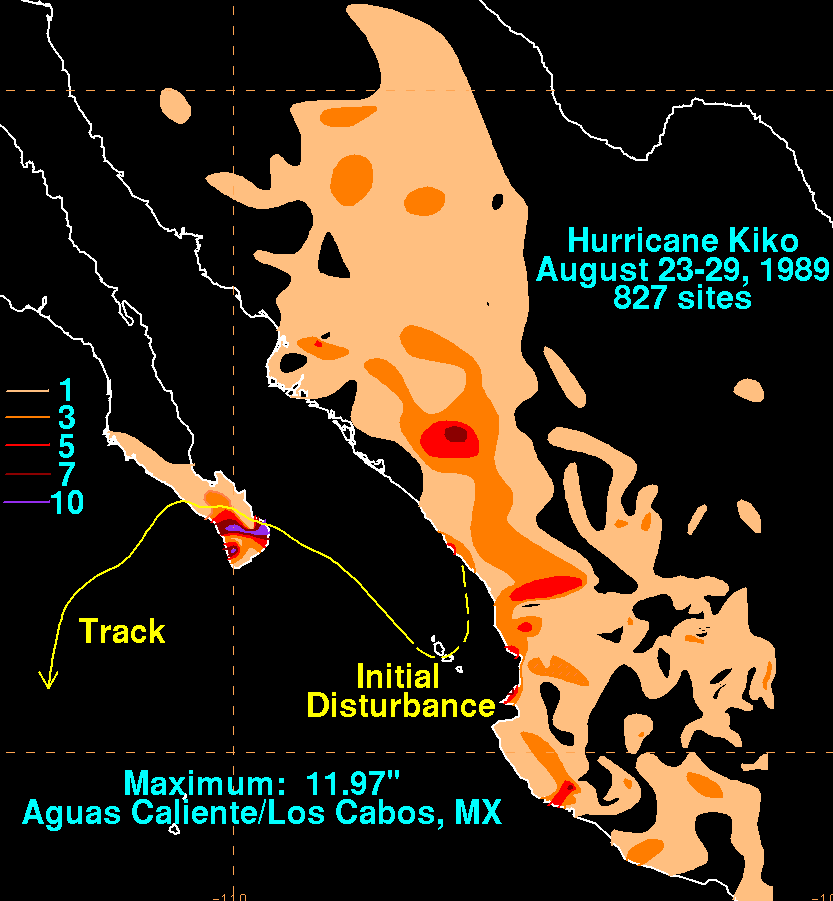|
List Of Storms Named Kiko
The name Kiko has been used for a total of twelve tropical cyclones worldwide: In the Eastern Pacific: * Hurricane Kiko (1983), paralleled the Mexican coastline * Hurricane Kiko (1989), struck Baja California causing minor damage * Hurricane Kiko (2001), stayed in the open ocean * Tropical Storm Kiko (2007), killed 15 people in Mexico without ever making landfall * Hurricane Kiko (2013), never threatened land * Hurricane Kiko (2019), long-lived tropical cyclone that stayed in the open ocean In the Western Pacific: * Typhoon Nari (2001) (T0116, 20W, Kiko) - An erratic typhoon that struck Ryukyu Islands, Taiwan and China * Typhoon Khanun (2005) (T0515, 15W, Kiko) - A costly Category 4 typhoon that affected China * Typhoon Morakot (2009) (T0908, 09W, Kiko) - A deadly typhoon that struck Ryukyu Islands, Taiwan and China * Tropical Storm Mangkhut (2013) (T1310, 10W, Kiko) - A weak tropical storm that struck Vietnam * Tropical Storm Guchol (2017) (T1717, 19W, Kiko) - A weak tropi ... [...More Info...] [...Related Items...] OR: [Wikipedia] [Google] [Baidu] |
Tropical Cyclone
A tropical cyclone is a rapidly rotating storm system characterized by a low-pressure center, a closed low-level atmospheric circulation, strong winds, and a spiral arrangement of thunderstorms that produce heavy rain and squalls. Depending on its location and strength, a tropical cyclone is referred to by different names, including hurricane (), typhoon (), tropical storm, cyclonic storm, tropical depression, or simply cyclone. A hurricane is a strong tropical cyclone that occurs in the Atlantic Ocean or northeastern Pacific Ocean, and a typhoon occurs in the northwestern Pacific Ocean. In the Indian Ocean, South Pacific, or (rarely) South Atlantic, comparable storms are referred to simply as "tropical cyclones", and such storms in the Indian Ocean can also be called "severe cyclonic storms". "Tropical" refers to the geographical origin of these systems, which form almost exclusively over tropical seas. "Cyclone" refers to their winds moving in a circle, whirling round ... [...More Info...] [...Related Items...] OR: [Wikipedia] [Google] [Baidu] |
Hurricane Kiko (1983)
The 1983 Pacific hurricane season was the longest season ever recorded at that time. It was a very active Pacific hurricane season. The season started on May 15, 1983 in the eastern Pacific, and on June 1, 1983 in the central Pacific, and lasted until November 30, 1983. These dates conventionally delimit the period of each year when most tropical cyclones form in the northeastern Pacific Ocean. During the 1983 season, there were 21 named storms, which was slightly less than the previous season. Furthermore, twelve of those storms became hurricanes. And eight of the storms reached major hurricane status, or Category 3 or higher on the Saffir–Simpson hurricane wind scale (SSHWS). The decaying 1982–83 El Niño event likely contributed to this level of activity. That same El Niño influenced a very quiet Atlantic hurricane season. The first storm of the season, Hurricane Adolph, became the southernmost-forming east Pacific tropical cyclone on record aft ... [...More Info...] [...Related Items...] OR: [Wikipedia] [Google] [Baidu] |
Hurricane Kiko (1989)
Hurricane Kiko was one of the strongest tropical cyclones on record to have made landfall on Mexico's Baja California peninsula. The eleventh Tropical cyclone#Naming, named storm of the 1989 Pacific hurricane season, Kiko formed out of a large mesoscale convective system on August 25. Slowly tracking northwestward, the storm Rapid deepening, rapidly intensified into a hurricane early the next day. Strengthening continued until early August 27, when Kiko reached its peak intensity with winds of . The storm turned west at this time, and at around 0600 UTC, the storm made landfall near Punta Arena, Mexico at the southern tip of Baja California Sur. The hurricane rapidly weakened into a tropical storm later that day and further into a tropical depression by August 28, shortly after entering the Pacific Ocean. The depression persisted for another day while tracking southward, before being absorbed by nearby Tropical Storm Lorena. Though Kiko made landfall as a Categor ... [...More Info...] [...Related Items...] OR: [Wikipedia] [Google] [Baidu] |
